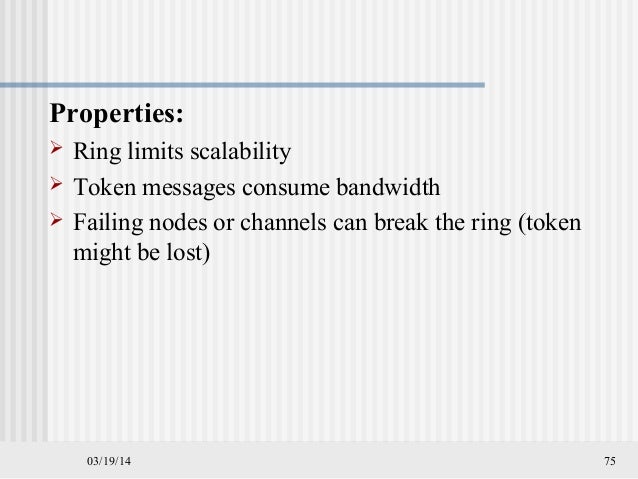Token Ring Implementation In C

Token Ring protocol is a communication protocol used in Local Area Network (LAN). In a token ring protocol, the topology of the network is used to define the order in which stations send. The stations are connected to one another in a single ring. It uses a special three-byte frame called a “token” that travels around a ring. It makes use of controlled access mechanism. Frames are also transmitted in the direction of the token. This way they will circulate around the ring and reach the station which is the destination.Ring Latency –The time taken by a single bit to travel around the ring is known as ring latency.Where,d = length of the ringv = velocity of data in ringN = no.

Token should be passing to users in order of joining server for amount of 10 seconds. Example: user A joined server, user B joined server, user C joined server. Server passes token to user A for 10 seconds, and user A can write messages for 10 seconds (for example, sending button is disabled by default, and server pass token = true to client. VLANs are implemented on switches, refer to the Catalyst Token Ring Switching Implementation Guide, the Catalyst 5000 Series Token Ring Configuration Notes, the Catalyst 3900 Token Ring Switching User Guide, and the Catalyst 3920 Token Ring Switching User Guide.
Of stations in ringb = time taken by each station to hold the bit before transmitting it (bit delay)Converting N.b into sec – RL = d/v + (N.b)/B (B – bandwidth)Converting d/v into bits – RL = (d/v).B + N.b (B – bandwidth)Cycle Time –The time taken by the token to complete one revolution of the ring is known as cycle time. Cycle time = T p + (THT.N)Where, THT - Token Holding TimeT p - Propagation delay(d/v)Token Holding Time (THT) –The maximum time a token frame can be held by a station is known as THT, by default it is set to 10msec. No station can hold the token beyond THT.Calculating THT:1.
Token Ring Hardware

Delayed token reinsertion (DTR) –. In this, the sender transmit the data packet and waits till the time the whole packet takes the round trip of the ring and return to it. When the whole packet is received by the sender, then it releases the token.
There is only one packet in the ring at an instance. More reliable than ETRIn this case,THT = T t + RL= T t + T p + N.b (In most cases, bit delay is 0)So, THT = T t + T pwhere T t = transmission delayT p = propagation delay2. Early token reinsertion (ETR) –. Sender does not wait for the data packet to complete revolution before releasing the token.
Let's have a look at the differences between the old and the new requirements:previously you wanted to send messages vrom a client to a server, and from there to all (other) clients, which works fine if you pass the message as string, without any other protocol. If a client receives something, you can be sure that's a message string which is supposed to be displayed in your chat text box.now things are a bit different: you have to distinguish between messages that are to be displayed, and control messages, that inform about the token. What you need is some sort of protocol for that.something that tells a listener if the message contains a chat-message, or a control message.control messages inform the client about things like 'hey client. You got the token. Sending is allowed for 10 sec.' , or 'your permission to send has been revoked', etc.based on those messages you can enable/disable your client's send button.on the other hand, you will have to implement the servers part aswell: managing the token and sending the appropriate control messages to the clients.
First you will have to define a protocol for those messages. You can define your own, or implement something like the IRC protocol ( ) but IRC seems a bit oversized for your application. Maybe just prefix every chat message with MSG and the control messages for the token could be 'TOKEN '. You can distinguish a chat message from a token just by looking at the first word, and then give the string to the appropriate handling function (chat-message? - output to user / control-message? - do something else)–May 22 '11 at 20:19.
